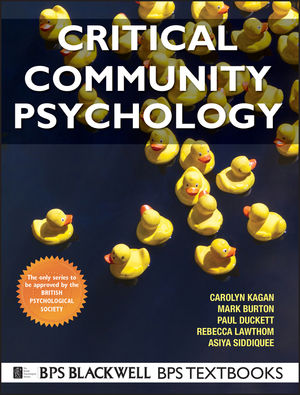|
Textbook
Critical Community PsychologyISBN: 978-1-4051-8884-5
Paperback
400 pages
May 2011, ©2011
 This is a Print-on-Demand title. It will be printed specifically to fill your order. Please allow an additional 10-15 days delivery time. The book is not returnable.
|
||||||
1 Introduction 1
Critical community psychology in Manchester 2
Why Manchester? 3
Learning through action and action through learning 5
Action learning 7
Action research 7
Language, discourse and representation 9
What do we mean by ‘critical’? 12
Orientation to the book 13
PART I: THINK! 15
2 What is critical community psychology? 17
The nature and origins of community psychology 18
Definitions 21
The emergence of community psychology in different parts of the world 24
Key themes in critical community psychology 28
Core values underpinning a critical community psychology 36
Social justice 37
Stewardship 38
Community 38
Conclusion 39
3 Core elements of a critical community psychology 41
Elements of critical community psychology 42
The ecological metaphor 42
The systems perspective 47
Multiple levels of analysis 48
The person-in-context 49
Working together 59
Prefigurative action 60
Core principles underlying a critical community psychology 62
Diversity 62
Innovation 62
Liberation 63
Commitment 63
Critical reflection 63
Humility 63
Conclusions 67
4 The contested nature of community 69
What is community? 71
Theory descriptions of community 73
Dimensions of community: Sentiment, social structure and space 74
Sentiment 74
Space 79
Social structure 81
Multi-dimensional communities 83
Social exclusion 85
Conclusions 87
5 Community as social ties 89
Social ties 90
Affection 91
Interdependence 91
Coercion 92
Theory prescriptions for community 93
Ties of affection and co-operation: Community as social capital 94
Ties of coercion: Community as ghetto 98
Social boundaries: benign or benevolent? 102
Community and social policy 103
Nature of participation 104
Conclusion 110
Critical disruption of Think! 111
Critically disrupting the challenge to individualism 111
Critically disrupting our history of community psychology 113
Resources for Part I 117
PART II: ACT! 121
6 Problem definition 123
Social issues 125
Need 126
Positionality and problem defi nition 130
Whose need? 131
Getting to know the community 132
Community audit 132
Community profi ling 133
Use of statistics 137
Observation 137
Community walks 138
Making contact and gaining entry in the community 139
Problem situations as human systems 142
Stakeholders and stakeholder analyses 151
Conclusion 154
7 Action planning 155
Decision making 156
Stakeholder analysis and action planning 160
Boundary critique: towards value-based decision making 161
Fourth generation evaluation 168
Participatory appraisal of needs and development of action 169
Strengths, weaknesses, opportunities and threats 170
Force field analysis 171
Option appraisal 174
Compromise 175
Visioning 176
Mixing methods 178
Complex decision making: Polarity management 179
8 Action 1: Furtherance of critical consciousness and creation of new forms of social settings 183
Action for change 184
Strategies of critical community psychological action 186
Furtherance of critical consciousness (conscientisation) 186
Problematisation 188
Experiential learning 191
‘Capacitation’ 195
Deideologisation 197
Creation of new forms of social relations and settings 198
Multi-dimensional nature of social situations 198
Behaviour settings 200
New or alternative social settings 202
The radical nature of alternative social settings 206
9 Action 2: Development of alliances, and accompaniment, advocacy and analysis of policy 209
Making links, the development of alliances and counter systems 210
Processes of making links and working together 210
Communities of interest or communities of practice 213
Alliances and coalitions 213
Partnerships 216
Working at the ecological edge 217
Alliances, new social settings and connecting with social movements 222
Accompaniment, advocacy and analysis of policy 224
Accompaniment 224
Advocacy 228
Analysis of policy 234
Conclusions 240
Critical disruption of Act! 241
Chronic uncertainty 242
Work ethic 243
Resources for Part II 245
PART III: REFLECT! 249
10 Evaluation 251
Purpose of evaluation 252
Principles of evaluation 253
Evaluation frameworks 255
Politics of evaluation 259
What is to be evaluated? 261
‘Theory of change’ perspectives on evaluation 262
Realistic or realist perspectives on evaluation 263
Capacity building for evaluation 268
Participation and evaluation 270
Participation and empowerment in evaluation 271
Resistance to involvement as a barrier to participation in evaluation 274
Skills for evaluation 276
Conclusions 278
11 Change, influence and power 279
The nature of social change 280
Incremental or radical change 283
Linear and non-linear change 284
Stage approaches to change 285
Strategic change 286
Resistance to change 287
Action research as change 290
Social movements, power and ideology 291
Social influence 292
Social change tactics 294
Social power, powerlessness and empowerment 294
Taxonomy of power 295
The social structure of social power 298
Power analysis 300
12 Roles, skills and refl ections on learning for community psychologists 303
Roles for facilitating change 304
Facilitation roles 304
Educational roles 304
Representational roles 305
Technical roles 306
Skills for facilitating change 307
Interpersonal communication skills 308
Social problem solving skills 308
Organisation skills 309
Research skills 309
The context of community psychological action 310
Reflexivity as part of practice 314
Constraints on working as a community psychologist and spaces for resistance 316
Ethical issues 319
Risk 320
Power (again) 322
Prefigurative learning 323
The case for and against community psychology 323
Community psychology as oppression or liberation 325
Conclusion 327
Critical disruption of Reflect! 329
Evaluation and the audit culture 329
Auditing skills 331
Critical disruption of critical reflection 333
Resources for Part III 335
13 Critical disruption: Does critical community psychology have an adequate praxis? 337
A new context: extreme and globalised oppression 340
Rethinking the amelioration–transformation distinction 341
References 343
Index 369



